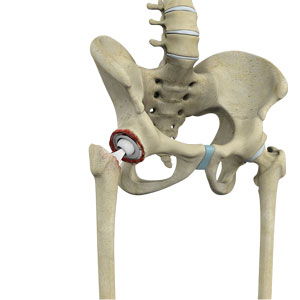Revision Total Hip Replacement (Arthroplasty)
What is it?

While total hip replacement usually provides long-lasting comfort and function for patients with hip arthritis, on occasion, problems can arise. Whenever a hip joint replacement fails to work well, a thorough investigation is needed to establish the nature of the problem and the possible approaches to remedy the situation. Some of the recognized causes of hip arthroplasty failure include infection, loosening, and dislocation. When we meet someone with a failed hip replacement, we gather all the possible information about the original diagnosis and the surgery – a copy of the operative note and the past x-rays are most helpful. We conduct a thorough physical examination and take special x-rays and other images to further assess the problem. Other tests, such as blood work and an aspiration of joint fluid for laboratory analysis may shed further light on the problem. Sometimes non-operative management, such as exercises or bracing, can be helpful. A revision surgery may be necessary to address the problem. The type of revision surgery depends on the nature of the problem
-
Revision for infection
- Revision for infection is complicated. The vast majority of the time, a “two stage” revision is required- meaning two surgeries are needed. The primary hip needs to be removed, cement with antibiotics is placed to allow the infection to clear for about 3 months, and then a new hip is replaced.
-
Revision for loosening
- The hip can “loosen” or fail to ingrow after the primary surgery. This may be a difficult diagnosis to make. Generally we need to compare x-rays obtained over time to see a change in the position of the implant and a loss of bone. Once this diagnosis is made, and we are certain there is no infection, we can proceed with a revision of the total hip.
-
Revision for dislocation
- The hip may be unstable and may dislocate. This may be improved with a surgery to change the position or the implants.
Revision hip replacement can be a challenge for both the patient and the surgeon. However, many patients with poorly functioning hip replacements can expect improvements after revision surgery.
How is it performed?
Revision hip replacement follows similar principles to primary hip replacement. Because there can be substantial variability between different hips that need to be revised, it is difficult to generalize how a revision surgery will be performed. However, here are some basic differences between primary and revision hip replacement.
- Your old incision may or may not be able to be used. Since revision surgery typically takes more exposure, it is difficult to perform "minimally invasive" approaches.
- Your bone may need to be split in order to remove the old hip replacement. Every effort is made to retain old components or remove them without damaging your exisiting bone, however, sometimes this is not possible because your bone has adhered tightly to the old implant or the old components were not placed in optimal position.
- You may need more than one surgery to give you the final revision replacement. This is particularly true of hips that need to be revised due to infection.
What are the risks?
Major medical complications are rare during the peri-operative period of a total hip replacement. We screen patients carefully to ensure that they are at a minimal risk for any of these complications. Aside from routine surgical and anesthetic risks, below are some of the most common risks associated with a revision hip replacement. In general, revision surgery poses a greater risk for each of these complications compared to primary surgery
- Dislocation
- Infection
- Leg length discrepancy
- Residual pain or limping
- Nerve Injury
- Blood clots
What is the difference between a primary and a revision hip replacment
A primary and a revision hip replacement can be dramatically different. Revision hip surgery may be unpredictable and more difficult for the patient and the surgeon. Typically, a surgeon needs to operate through scar tissue. Additionally, the reason for needing to revise the hip can vary widely. This also means that the results from surgery can be variable. The rehabilitation is typically more prolonged than a primary replacement. This does not mean that revision surgery cannot improve your symptoms, it just means that it may not function the same as a primary hip replacement.
The x-rays to the right demonstrate some of the differences between a primary and a revision hip replacement. The top x-ray is an example of a primary hip replacement and the bottom x-ray is an example of a revision hip replacement.
How do you know if you are a good candidate for revision hip replacement?
- We try to optimize all of our patients for surgery.
- At times, the timing of surgery is more urgent, such as in cases of irreducible dislocation, infection or fracture.
- Most of the time we would like to take the time to optimize your health prior to revision surgery.
- Additionally, it is important that your surgeon has a good understanding for why the prior replacement is not functioning very well. If it is not clear why the prior implant is not functioning very well, then the success of revision surgery is unpredictable.
Who is not a good candidate for a revision total hip?
The following conditions are known to be associated with worse outcomes after revision surgery.
- Patients with severe spinal problems
- Patients on chronic pain medications
- Patients who actively smoke
- Patients in poor general health and physical conditioning
- Patients with a BMI > 40
- Patients with severe edema
While having any of these conditions does not mean that a revision total hip arthroplasty cannot be performed, it could mean that alternative methods of treatment may be safer and more predictable.






